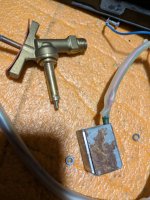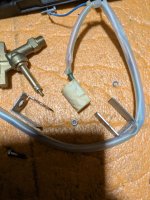The PO told me the water heater worked, but I didn't test it when i bought the van.
I had a Gas Safe guy out and we did a bit of investigation. Not sure if had been a blockage in the gas feed, but if there was, he freed it, as we had gas at the connection next to the heater.
He told me to clear the jet out and try again.
The only way i could do this was to remove the water heater (which was a bit of a pain). I then fed some air into the heater burner and made sure there was no blockage - as far as i could tell, there wasn't.
Anyway, I put the heater back in, but no joy: when i turn it on, i can hear the clicks (which i assume means the igniter is working but no other evidence) but after 8 seconds or so, it goes into error mode on the control panel.
When i took the heater out, it wasn't obvious how to get closer to the burner to investigate. If i remove it again and take stuff apart, what should i be looking for?
Or should i give up and look for a replacement?
I had a Gas Safe guy out and we did a bit of investigation. Not sure if had been a blockage in the gas feed, but if there was, he freed it, as we had gas at the connection next to the heater.
He told me to clear the jet out and try again.
The only way i could do this was to remove the water heater (which was a bit of a pain). I then fed some air into the heater burner and made sure there was no blockage - as far as i could tell, there wasn't.
Anyway, I put the heater back in, but no joy: when i turn it on, i can hear the clicks (which i assume means the igniter is working but no other evidence) but after 8 seconds or so, it goes into error mode on the control panel.
When i took the heater out, it wasn't obvious how to get closer to the burner to investigate. If i remove it again and take stuff apart, what should i be looking for?
Or should i give up and look for a replacement?







